Boston class fleet escort (missile conversion)
 US Navy. USS Boston, Canberra, 1953-78 (CAG-1, 2).
US Navy. USS Boston, Canberra, 1953-78 (CAG-1, 2).
US Cold War Cruisers:
Worcester | Des Moines | Juneau | Boston | Galveston | Providence | Albany class | Long Beach | Leahy | Belknap | Bainbridge | Truxtun | California | Virginia | Ticonderoga | Strike Cruiser (CSGN)The Boston class were the world’s first missile cruisers. They emerged from the idea missiles were the future against jet-powered high altitude bombers, and especially in 1951 when the Soviet threat seems all too real. Instead of waiting for three to four years the naval staff decided to convert two world war two veteran Baltimore class heavy cruisers: USS Boston and USS Canberra. They were converted between 1952 and 1955-56 with two RIM-2 terrier SAM launchers aft, full radar modernization, and keeping their forward artillery, which came in handy during their tours of duty in Vietnam, where they gained extra battle stars. Ultimately the planned 1969 second modernization never came due to budget constraints. Instead, money was spent on the Albany class, a grandiose, but flawed class of pure missile cruisers conversion also based on baltimore class vets. They would remain the largest missile cruisers ever built before the Soviet Kirov class. #pacificleet #baltimoreclass #coldwar #missilecruisers #cag1 #vietnamwar
Context of the Conversion
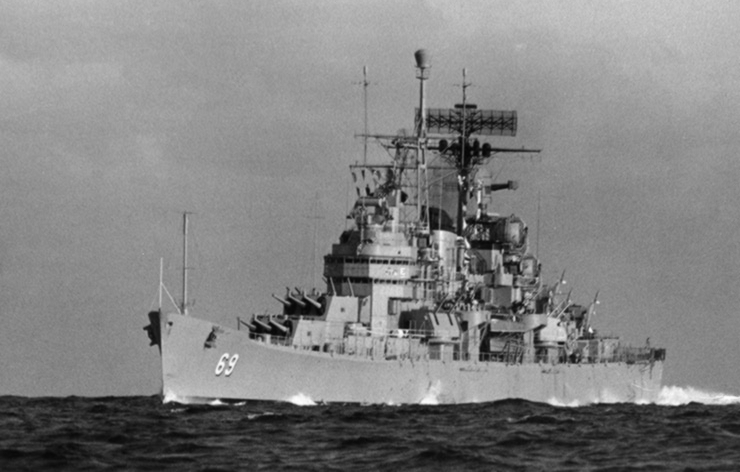
In the budget-strapped context of the 1950s, the Navy was found itself with a large conventional fleet that was ageing and likely not revelant in the late 1950s against the newt jet threat to defend aircraft carriers. Alongside a flew large fleet escorts like USS Norfolk and the Mitscher class, still gun-armed the Navy wanted to experiment with early missiles which required large ships.
In particular the danger of Soviet high altitude bombers became a haunting for the Navy and its precious carriers, added to the fact Stalin had the bomb in 1953. A single bomber could wipe out an entire task force. Naval interceptors needed time to altitude for interception, so supersonic, even Mach 3 long or medium range missiles were the only solution.
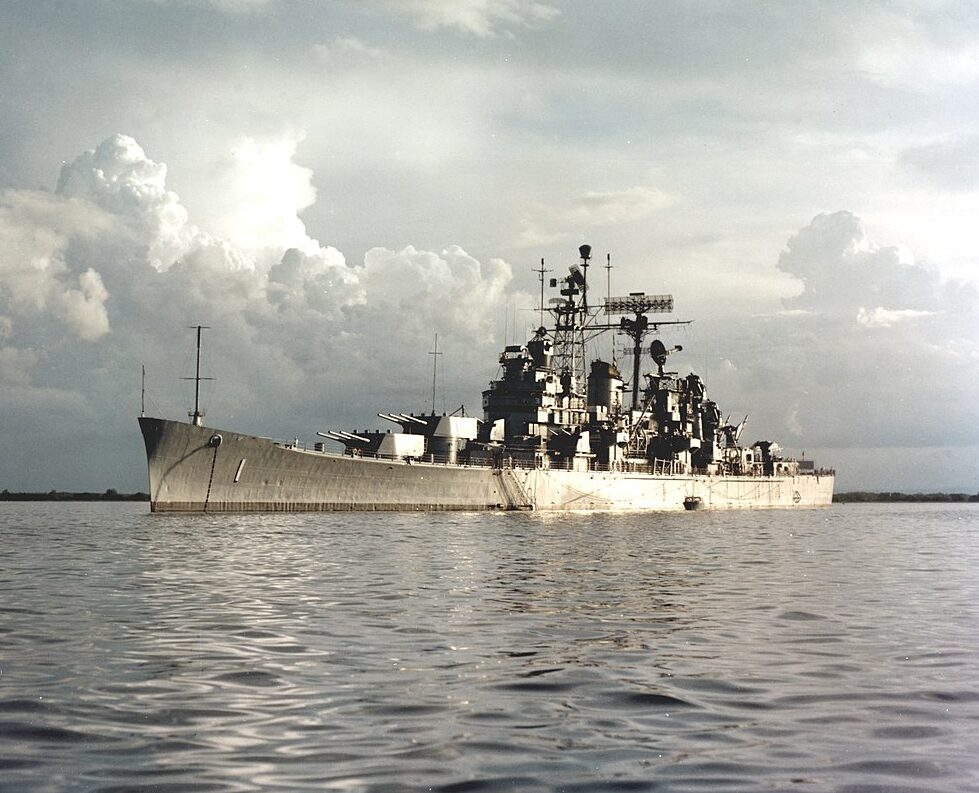
CAG-1 USS Boston off Guantanamo Bay 10 September 1963
The US missile program (The three “T” notably of the Navy, see later) was solidly underway, thanks notably to the help of German scientist rallied under Operation Paperclip.
The naval staff in 1945 was indeed familiar with guided bombs as much as early missiles, since the loss of USS Savannah (CL-42) hit by a German Fritz-X radio-controlled glide bomb off Salerno operation in September 1943, and not long after the destruction of the Battleship Roma en route to Malta in the same way. In 1945 Germany worked on a dozen missile programmes, ballistic, cruise, anti-ship, anti-aircraft and anti-tank. 1942 showed to the USAAF the total impotence of high altitude bombing against naval targets, instead of the almost surgery strikes of dive bombers which proved their worth notably at Midway. The Kamikaze experience also showed the validity of the concept of flying directly to the target, and what could happen if the pilot was replaced by a radio-controlled system, which led to some tests in 1944-45 as well. Thus, everything was pointing towards the end of the “spray and prey” (artillery or bombs) and towards the precision semi-autonomous ordnance. But these new weapons developed in the late 1940s and early 1950s needed ships as carriers.
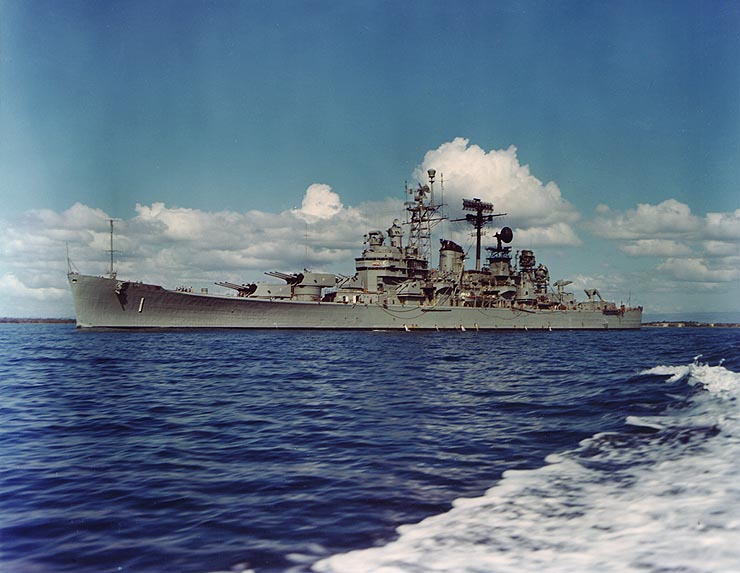
USS Boston off Cuba 1969
Instead of building new ones, some suggested to convert large hulls of the WW2 legacy Cleveland and Baltimore class cruisers to reduce time (more than costs). To test the medium range RIM-2 Terrier SAM it was chosen to convert two of the Baltimore class heavy cruisers in the best shape, USS Boston and later USS Canberra, keeping their conventional artillery forward, but with the aft section completely modified and converted to operate two twin SAM ramps. This enable not only to spare the construction of a brand new ship, but also keep part of the artillery capability and reduced also the conversion cost. The recipe proved not cost-saving, far less than than anticipated, just enough to launch a similar conversion on six Cleveland class light cruisers (The Galveston class) a few years afterwards, alternating between Terrier and Talos missiles. Then came the logical end of this process, converting remaining Baltimore class cruisers as “pure” missiles cruisers, the three Albany classn recommissioned in 1962-64 and comning Talos and Tartar system for a double protection bubble.
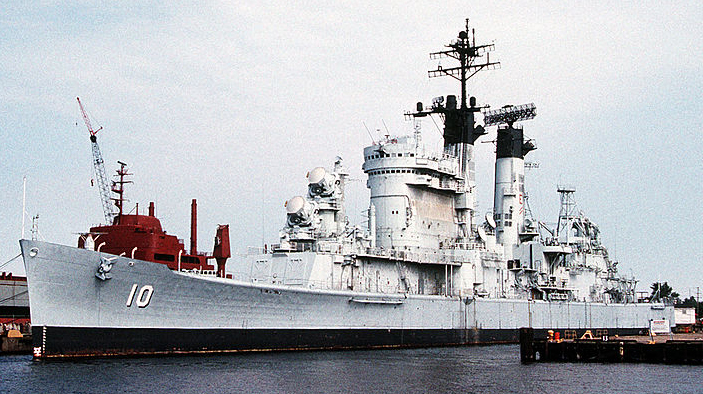
The Albany class missile cruisers, the “purest” interpretation of the missile conversion concept applied to the Baltimore class heavy cruisers.
However the latter were not perceived that successful. The conversion proved very costly and the ship themselves costly platforms to operate. Some in the Navy argued that brand new, tailored ships for the role, which would be tailored and thus smaller, was a more long-term economical solution. Hence the construction of the Leahy class cruisers, started in 1959, with nine ships built until 1964, mirroring the Charles F. Adams class missile destroyers. The 5,200 tonnes Leahy (and later 5,500 tonnes Belknap) proved indeed far better suited platforms than the 18,000 tonnes converted Baltimore. Highy automated they also only “consumed” a crew of 377 versus 1,266 on the Albany or worse, 1,544 on the Boston class. A choice easy to make for the American taxpayer…
In the end, these Boston conversions were an easy, quick solution, instead of waiting for a new tailored design to emerge (four years as estimated from initial design to commission). It would be noted that the experience gained on the Boston class was instrumental during the design of the Leahy class. Despite of their operation costs, the Boston and Canberra managed to stay in service for two decades, until 1973 and 1978, proving the concept was still relevant, but modernizations were rejected as too costly, as the application of Phase II (see below). Full missile conversion was done instead on the Albany class later, and they proved to be the largest cold war -missile or otherwise- US cruisers, even compared to the unique USS Long Beach, 2,000 tonnes smaller. Some also suggested to convert the more modern DesMoines class, but the Navy rejected it on the ground they at last had their rapid fire heavy cruisers, and needed them for this role.
Design of the Reconversion
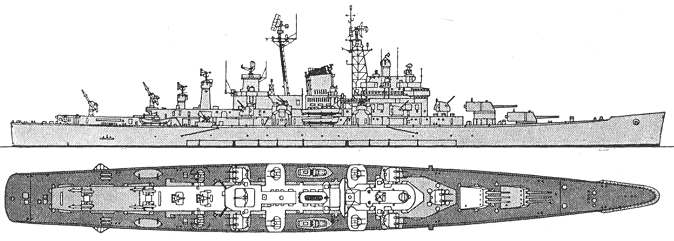
The very severe perceived threat of new jet-powered high altitude Soviet Bombers led to rushing the conversion of two Baltimore class ships in 1953, with a plan of an “austere” first phase (only the aft part converted) and if successful, ported forward in Phase II. This was not done for them, but for the Albany class later. Before than even, in 1952, it was considered converting instead the older USS Wichita completely (three launchers, earch replacing a turret), but this was latter dropped. Decision was mostly dictated by several factors, notably recent overhauls, good general state, and this included the absence of severe wartime damage on Boston and Canberra, which were also the two earliest of the class, after USS Baltimore herself.
So from the start to simply the conversion process it was decided to concentrate only on the aft part, making these ships hybrids, still able to used their forwards artillery, six 8-in guns, but also five of the six original secondary 5-in/38 gun turrets, the one superfiring forward, two wings forward and two wings aft ones.
However the entire aft part of the ships in drydock was gutted down to the armour deck, above the machinery. Everything inside that section was removed, starting at the unique funnel which replaced the original funnel pair to gain space, truncating exhausts. This was reusing the sub-class Oregon City as example. Originally it was done to free and optimize the largest arc of fire for AA armament. In the context of the new conversion it enabled to clear up extra space to house the accomodations and operating systems for the two twin missiles ramps.
The ramps were in the axis, heavenly separated and slaved to one guiding radar for each.
Essential radars were installed on a newly built derrick aft of the bridge, which was also enlarged, with extra accomodations built in and a two level glassed bridge on which were left the former fire control systems for the forward turrets. A pole mainmast was kept aft, but supporting new radars. Service boats were kept close to the main funnel amidships.
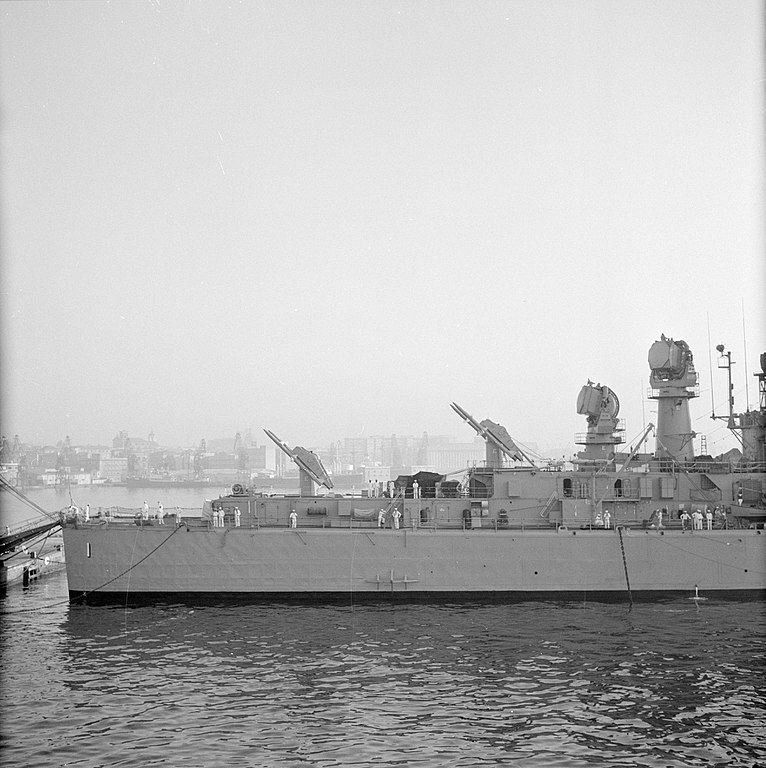
USS Boston, aft part, in Naples.
The hull was left virtually unchanged externally, as was the powerplant and associated armor protection (belt: 152-102mm, deck 64mm, barbettes 160mm, turrets 203-38mm) but it was revised, see later. See the Baltimore class for more. This means even after conversion, these ships still had four steam geared turbines fed by four babcock and Wilcox boilers for 120,000 shp and 35 knots, and a range of 7,300 nautical miles at 20 knots, based on 1448 tonnes of oil.
The ship after conversion was calculated to displace 13.589 tonnes standard and 17,947 tonnes fully loaded. This was close to the original (USS Oregon City 13,260 long-tons standard).
Armour protection revisions CAG-1
CAG-1 had her protection revised: The Main belt abreast machinery was extended to 1.5m (5 ft) below and 2.86m (9.3 ft) over the waterline, 152mm thick (6-in) (76mm or 3-in at lower edge), on a 16 mm (1-in) STS plating. Narrow belts were also applied abreast the magazines ranging from 51 at the lower egde to 76mm upper. Magazines were also protected by a 140mm (5.5-in) fore, and 127mm (5-in) aft bulkhead. The machinery and magazines were separated by 152 mm (6-in) bulkheads. Armoured deck over main belt was 65mm. Barbettes were 178 mm (7-in) thick and turrets her their 203mm (8-in) faces, 83-38 mm sides (3.2 to 2 in), 38mm back plates and 76mm crowns.
Armament: A mix of new and old
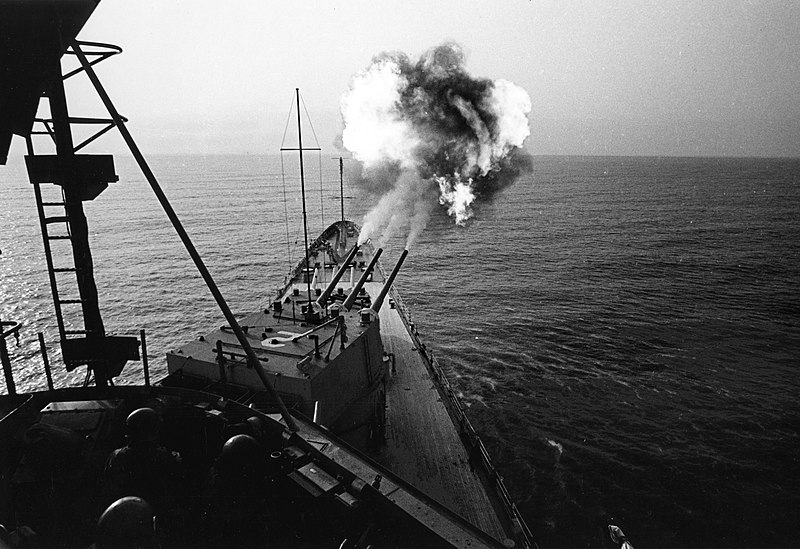
USS Canberra (CAG-2) fires at targets in Vietnam, 20 May 1967.
Main Guns: 6x 8-in/55 Mk.16
The two forward turret were kept intact. So the Boston class retained the capabilities of six 8-in/55 standard (203 mm) main guns.
They fired a 335 pounds (152 kg) A.P. or 260 pounds (118 kg) HE shell at 2,500 feet per second (760 m/s) up to 30,050 yards (27,480 m). The cruisers used them at several occasions in active combat, as they did already in WW2.
Secondary Guns: 10x Mk32 Mod4
Of the former WW2 battery, the cruisers kept all but the axial aftermost twin turret, so five twin. These standard of all standards were still usable against jets between their high rate of fire (15 rpm), fuses and excellent accuracy. They fired a 127×680mmR 55 lb HE frag shell at 2,600 ft/s (790 m/s) up to 18,000 yards (16,000 m) in range, 37,200 feet (11,300 m) in ceiling. More on these.
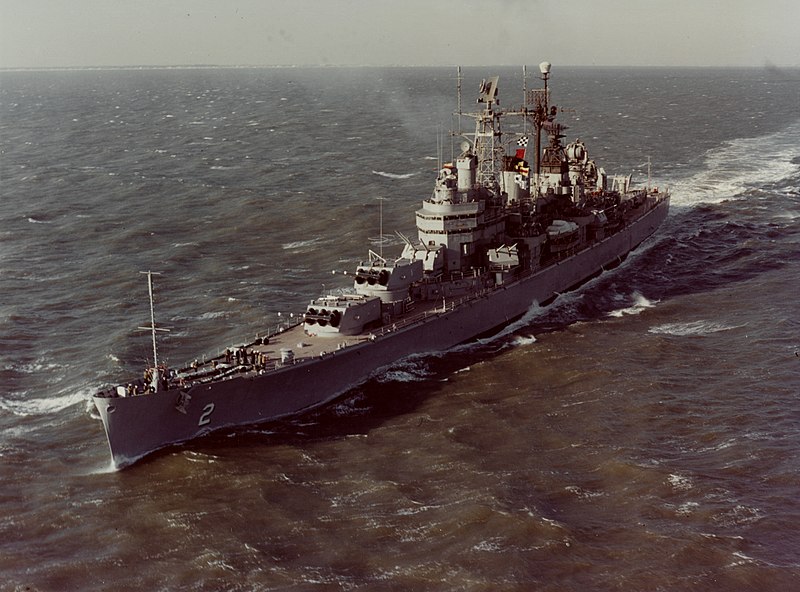
USS Canberra underway at sea 9 January 1961
AA Guns: 8x 3-in/50 Mk.33
If the second protection bubble failed (the first were the RIM-2 Terrier, the second were the 5-in/38) the third line applied. In the 1950s refit and modernization, all their remaining WW2 menagerie of 40 mm and 20 mm in quad, single or twin mounts was removed. In place, four of the brand new 3-in (76 mm) 50 caliber twin mounts were installed where the upper quad 40 mm mounts were located. Essentialy a postwar AA system, these replaced the Bofors, being found able to shot down the first generation of jets. More on these.
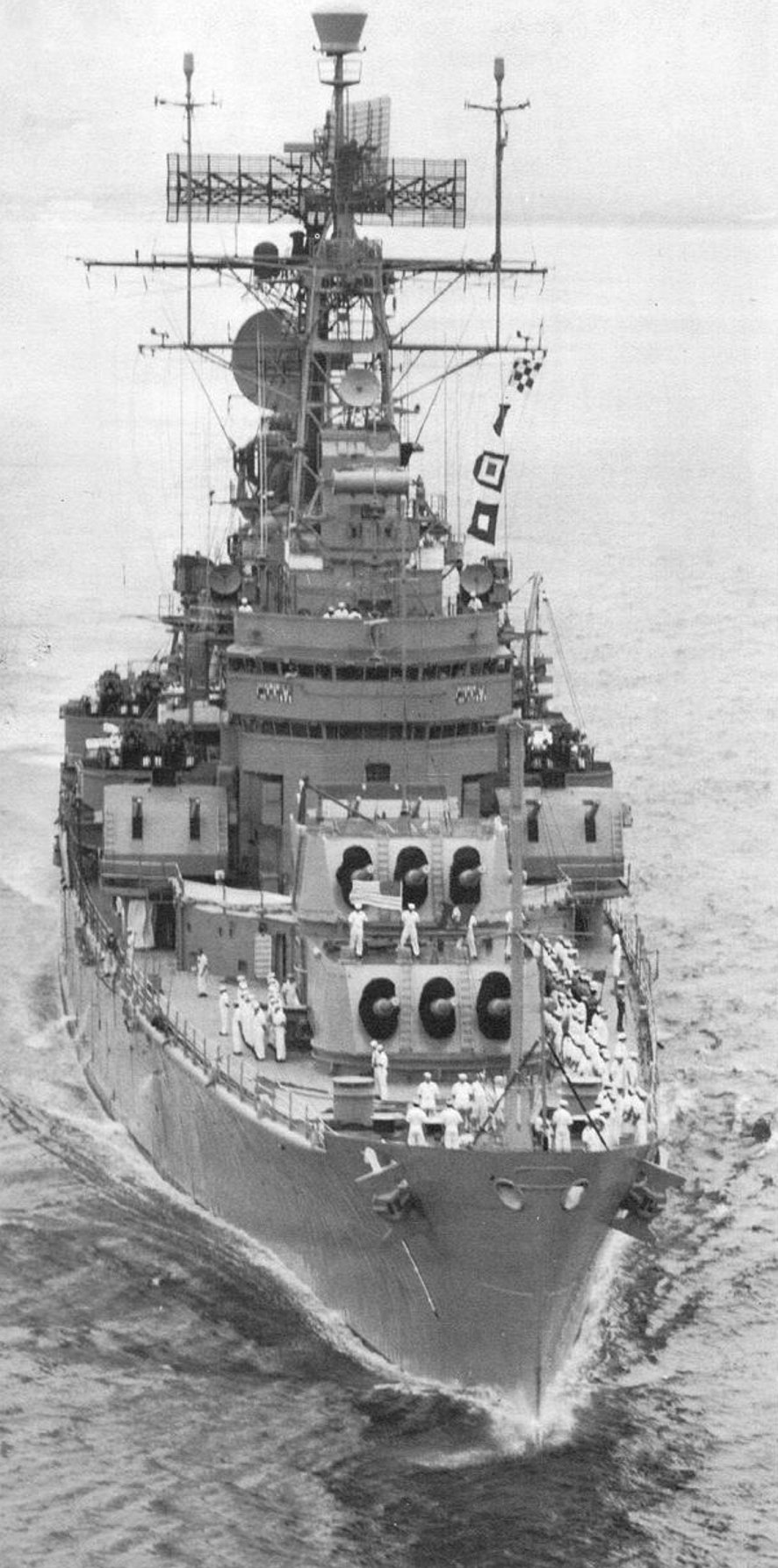
Bow view of USS Boston, still showing her “WW2 face”.
Mark 4 RIM-2 Terrier Missile System
The RIM-2 Terrier concept was initially close to the Talos, but diverged as development went on, focusing on smaller and medium-range targets. The warhead changed to a trusted blast-fragmentation system. It was at first a wing-controlled and beam-riding missile capable of 1.8 Mach over 10 nautical miles, tail-controlled with semi-active radar homing (mach 3.0 over 40 nautical miles, 80,000 feet ceiling). The standard on all USN ships (and NATO), 8,000 were built in all typically from twin launchers with quick reload and a variable number of missiles inside the hull brough with a complex conveyor belt system.
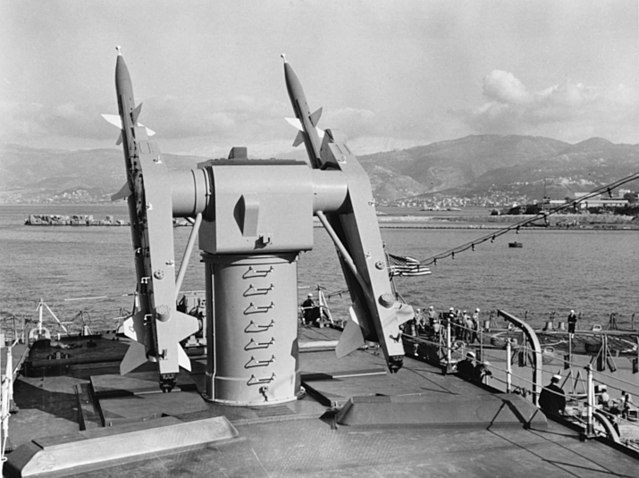
On USS Boston and Canberra they were was located aft as stated above, each on top of their own superstructure containing the conveyor belt system, in superfiring positions. They had 72 missiles each, for 144 in all, probably the largest missile load of any ship of this type at the time. On the Clevelad class which alternated between the Talos and Terrier, 120 missiles were however carried for the latter single aft launcher. The Terrier was replaced by the RIM-67 Standard Missile in the 1980s, but the upgrade was only done on the all-missile conversions of the Albany class, not the Botson class.

After section of USS Boston in Naples, showing the tw launchers and associated SPQ-5 guiding radars. USS Boston had the Mark 25 mod 7.
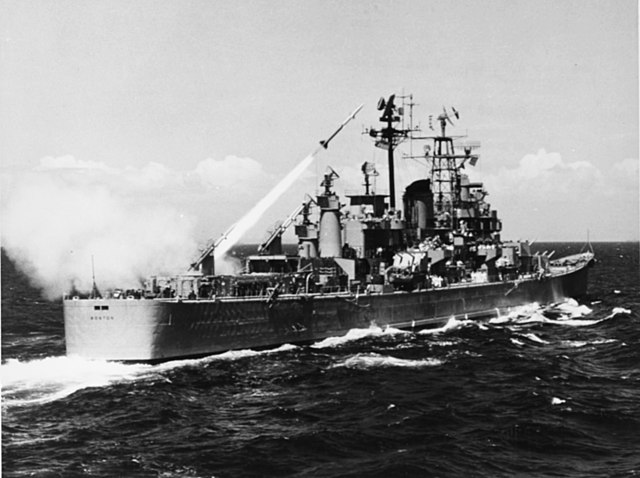
USS Boston firing the SAM RIM-2 Terrier in a test by August 1956.
It should also be noted that these ships had an helipad aft, but no permanent helicopter nor a housing for it. Its type depended on the location and missions. It was used for liaison an plane guard (rescue).
Sensors
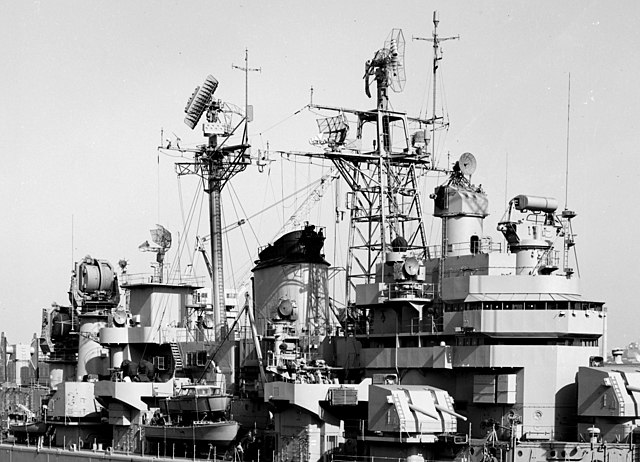
The Boston class received an all-out new electronics suite. It comprised the following:
AN/SPS-6: Air warning 2D radar 500 kW, L Band, range 130 – 260 km (70 – 140 nmi)
AN/SPS-8A: Eight finding 2D 650 kW radar, S Band at 1000 Hz (bwt 3.5°, pdt 2 µs) Range 111 km (60 nmi)
AN/SPS-10: Surface-search radar
AN/SPS-12: Improved SPS-6C, same but 12 MW, range 90 nmi (170 km) to 200 nmi (370 km), PRF of 300 to 600 pps
CXRX: Hemisphere-scan radar
SPQ-5: Guidance radar developed for the RIM-2 Terrier derived from the AN/SPG-49, first installed on the Boston class and only used on missile converted cruisers of the Providence class also.
Modernizations
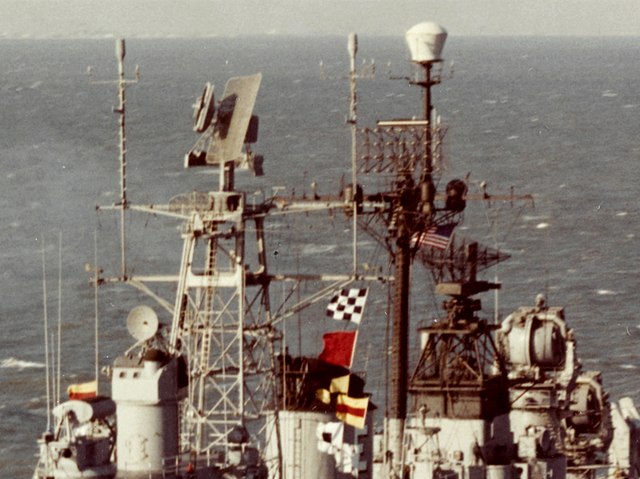
Later in 1957 and/or 1958 during refits, USS Boston and Canberra received a CXRX radar and a new SPS-8 radar.
In 1966 both Boston and Canberr were taken in hands for a sensors overhaul with their SPS-6, SPS-8, SPS-12 radars and twi SLR-2 EW suites being landed. Instead a new set was installed, comprising the SPS-37A, SPS-30 radars, WLR-1 and ULQ-6 ECM suites. Both served in Vietnam in this configiration, notably during the Têt offensive for Canberra.
After 1968 they were planed for another refit and complete modernization until 1970. Boston and Canberra should have their Terrier SAM launchers and associated SPQ-5 radars removed at the same time they were reclassified back as “CA” cruisers, retaking their original denominations. This was never carrier out for budgetary reasons. The Albany class was modernized instead.

Conway’s rendition of the Boston class.
⚙ specifications |
|
| Displacement | 13,560 tons standard, 17,947 tonnes FL |
| Dimensions | 673 ft 3 in x 71 ft 10 in x 26 ft 10 in (205.2 x 21.9 x 8.2 m) |
| Propulsion | 4x shafts steam turbines, 4x 4,615 psi boilers |
| Speed | 33 knots (61 km/h; 38 mph) |
| Range | 7300 nm at 20 kts, oil 1448t |
| Armament | 2×3 8-in/55, 5×2 5-in/38, 4×2 3-in/50, 2×2 Terrier SAM |
| Sensors (1955) | SPS-6, SPS-8A, SPS-10, SPS-12, 2x SPQ-5, CXRX |
| Sensors (1962) | SPS-13, SPS-29, 2x SPQ-5 2x SPG-35, AN/URN-3 TACAN |
| Protection | As original Baltimore class |
| Crew | 1,142 officers and enlisted |
 USS Boston (rec. 1955)
USS Boston (rec. 1955)

USS Boston off Cuba January 1967
After WW2 ended, USS Boston remained in the Far East on occupation duty, until 28 February 1946. Back home she was placed out of commission, reserve at Puget Sound Naval from 29 October 1946.
Discussions about her recommission was linked to the not to the Korean war as were 10 others of her class, but the decision to attempt a first missile conversion, using the SAM Terrier as main system. She was earmark for conversion after examination of her general condition as well as her sister ships USS Canberra and Chicago.
Her conversion as carry guided missile cruiser (reclassified CAG-1 on 4 January 1952) was performed from February 1952 when she was towed from Bremerton in Washington, to Philadelphia NyD via Panama, for a conversion performed later at New York Shipbuilding Corporation in Camden (New Jersey). As said above, her aft 8-inch turret was replaced with two Terrier systems and she was completely modernized, recommissioned on 1 November 1955 so nearly after three years. She became the lead ship of her class, operated along the east coast and Caribbean at first for her sea trials, shakedown to Cuba, and conducting her first missile evaluations. Then she was declared ready for service, and participated in fleet exercises until departing for the Mediterranean and her first operational deployment on 23 November 1956, until May 1957.

USS Boston in 1957
Later in 1957 she made a Midshipmen’s cruise to South America. She later took part in NATO exercises in the North Atlantic. She was overhauled in Boston, her namesake city, by 1958, and started second Sixth Fleet tour in the Mediterranean, in June to September 1958. She was present duing the Lebanon crisis. For the newt eight years, she operated in the Mediterranean as flagship and took part in more NATO exercises off Northern Europe, visiting many ports in the vicinity. This was alternated with local refits and Caribbean or East Coast training. USS Boston became flagship again during the recovery search after the Palomares Incident (B52 A-bomb drop) in February-April 1966.

Boston firing a Terrier in August 1956
In April 1967, USS Boston was reassigned to the Pacific. She transited the Panama Canal and joined the 7th Fleet via San Diego and Pearl Harbor. She was to take part in the Vietnam War, in her first tour of duty as part of Naval Gunfire Support Task Unit 77.8.9, firing her guns for the first time in anger since 1945. Later she took part in Operation Sea Dragon off North Vietnam, firing thousands of rounds of her main and secondary batteries against lands targets along the coast, and troops movements or ships down to the DMZ and South Vietnam. Nominally she was still homeported to the East Coast, but she made two more deployments to the Pacific, via Panama, notably by April–October 1968 and May–November 1969. Thus even though she was a “Mediterranean” 6th Fleet cruiser she was the first to had three TODs in Vietnam; By May 1968, Boston she was reclassified from “Guided-Missile Heavy Cruiser” to “Heavy Cruiser, Attack” (CA-69), retained her Terrier missiles, but now recoignesed obsolete. She had an overhaul in 1968 and lost some of her guns as well as her two aft Terrier launchers and associated FCS radar.
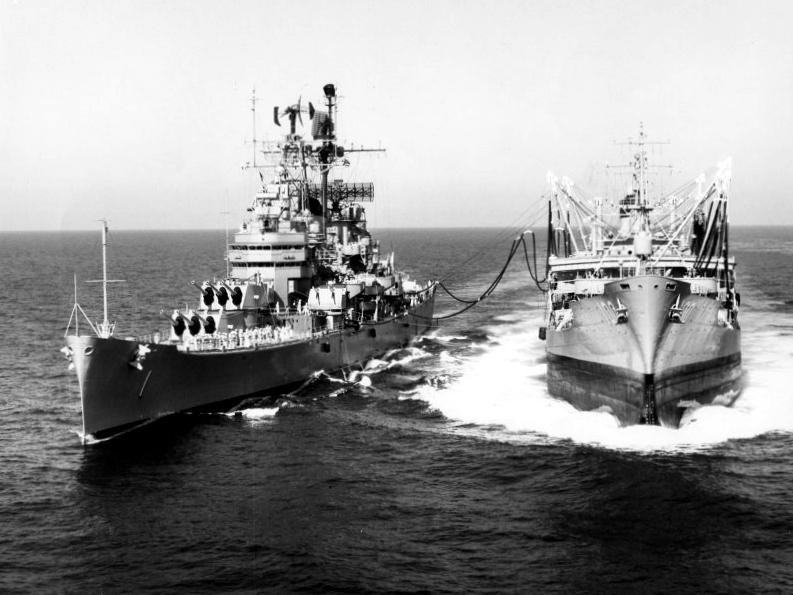
Refuelling in the Mediterranean to USS Chukawan (AO-100) in 1960
On 16–17 June 1968, while conducting naval gunfire off North Vietnam with destroyers USS Edson, USS Theodore E. Chandler, Australian HMAS Hobart, they were mistook for enemy ships and fired upon by USAF aircraft from the 366th Tactical Fighter Wing. Two missiles were launched at Boston, one exploding 200 yards (180 m) off her port beam, the other close to port. No sailors were injured fortunately and fires were quickly extinguished. The missiles launchers had minor structural damage. Hobart the same day was alsohit, by three missiles, this time killing two sailors, wounding eight more. When the attackers came back for a third pass, HMAS Hobart’s captain decided he had enough and decided to fire while radio contact at last made them understand their mistake. The later enquiry, as it was one of the most serious USN blue on blue incident in Vietnam, proved these missiles fired were AIM-7 Sparrow built in the US as comnfirmed by fragments found on Boston. PCF-19 was also struck by two missiles. The same day PCF-19 was sunk and USS Edson was also attacked by F4 Phantoms on the 17th. But it was proven that PCF-12 & 19, had been rocket-attacked by North Vietnamese helicopters and PCF-19 was apparently sunk by rockets.

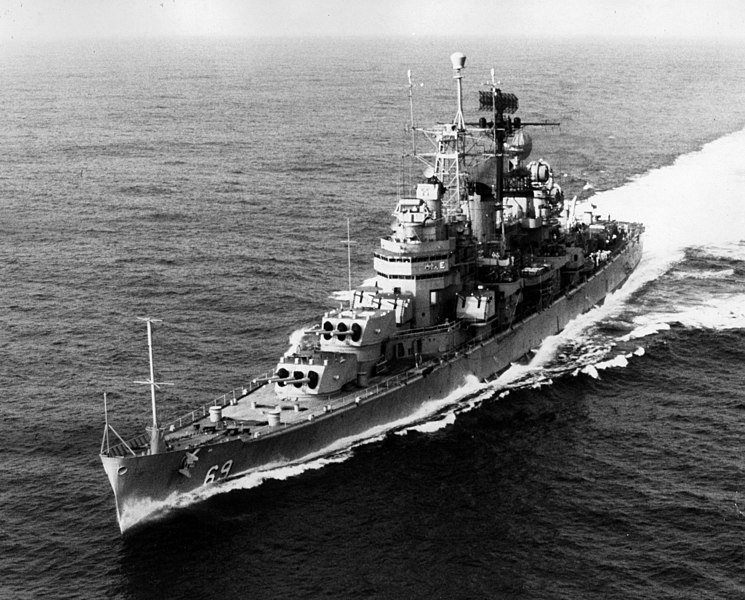
USS Boston in the south China sea in 1969
This was her last Vietnam cruise. She was sent for a final overhaul as her sister Canberra but it was curtailed and candelled: Her Terrier missile system would he been replaced by Standard Missiles, new radars and FCS and all her gunnery systems and electronics also overhauled. Budget cust prevented this, and USS Boston made instead her last family day at Boston in late 1969, before going into decommission. Senator Edward Kennedy wanted her preserved at Boston as a museum ship but no plans materialised. Inactivation started in the Navy Yard’s Annex from 5 May 1970, until she was stricken by January 1973, sold for BU by March 1975, which proceeded until 1976.
Her WW2 Asiatic-Pacific Campaign earned her 10 battle stars to which was added the Vietnam Service Medal with 5 battle stars, Republic of Vietnam Meritorious Unit Citation and Campaign Medals as well as a Navy Unit Commendation for her decisive naval gunfire support at the Battle of Đông Hà in May 1968.
 USS Canbera (rec. 1956)
USS Canbera (rec. 1956)
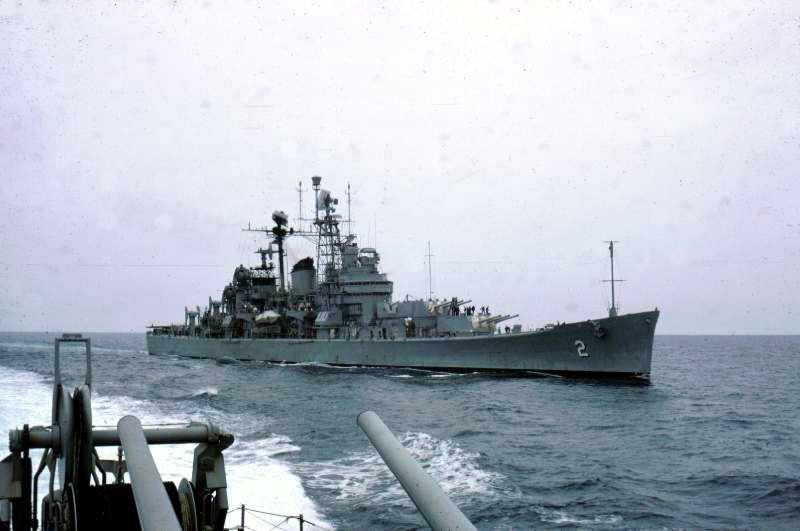
Canberra off the gulf of Tonkin in 1967
At the end of WW2 unlike her sister, USS Canberra was seriously hit: On 13 October, she received an air-dropped torpedo below her armour belt (23 killed) flooding her engineering spaces and later towed to safety by USS Wichita to Ulithi, to USS Ajax at Manus, and Boston, drydocked until October 1945. She did not returned to the Pacific and instead stayed on the west coast until the last days of the year, receiving seven battle stars for her WW2 service.
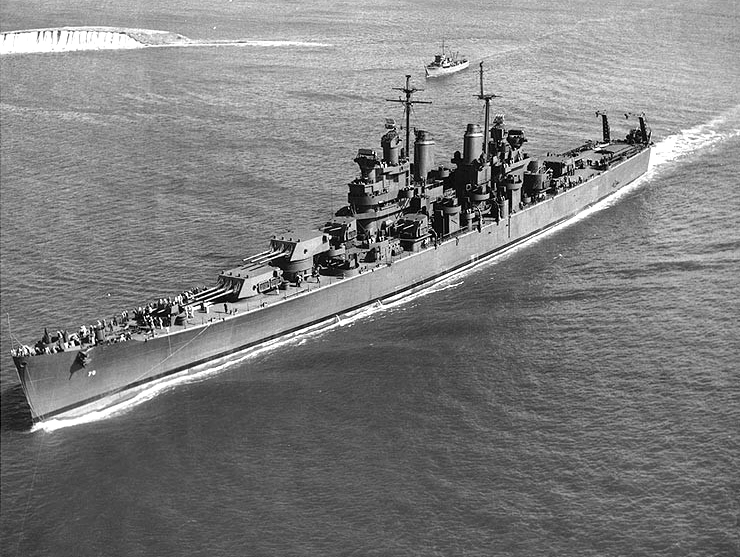
USS Canberra on 14 October 1943
Like her sister she was decommissioned on 7 March 1947, Pacific Reserve Fleet, Puget Sound Naval Shipyard and later towed to Bremerton in Washington. Like Boston she was earmarked in 1952 for conversion into guided missile cruisers, Canberra was redesignated with the hull number CAG-2 and on 4 January 1952, she was towed to the New York Shipbuilding Corporation at Camden, New Jersey, for conversion as missile cruiser, the world’s second of the type. The conversion ended by June 1956. Her phase 2 modernization of 1964 was cancelled.
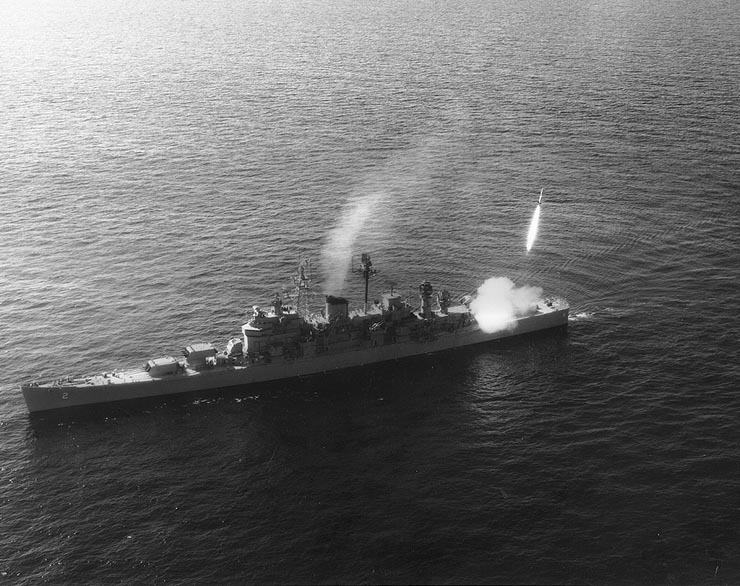
USS Canberra firing a Terrier in training, February 1957
Recommissioned on 15 June 1956, she was homeported at Norfolk in Virginia with the Atlantic fleet, tasked of escortin carriers or act independently as TG core and flagships. From June to March 1957, HP Norfolk she trained in the Caribbean and on 14 March carried President Dwight D. Eisenhower to Bermuda for a conference with British PM Harold Macmillan. On 12 June, she was the host review ship at the International Naval Review at Hampton Roads. Agter her summer cruise she departed for her first 6th fleet Med TOD, and NATO Operation Strikeback.
She would later return on 26 May caskets for the Unknown Soldiers of World War II and the Korean War with a ceremony, to be buried at Arlington National Cemetery.
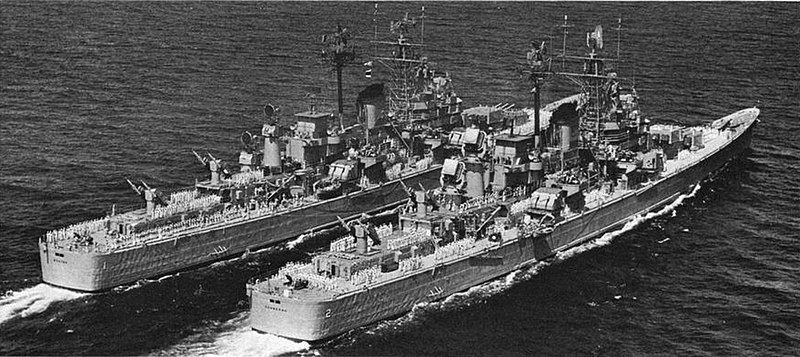
With her sister ship Boston underway on 22 April 1958
She was back home on March 1958 and by mid-April 1958, Boston and Canberra hosted a change of command at the head of CruDiv 4, Boston, between Rear Admiral Charles B. Martell and Rear Admiral Charles L. Melson. She made another summer cruise and was drydocked at Norfolk for overhaul. From 3 March to 24 October 1960, she made a 8-month round-the-world cruise, during which she made several missile demonstrations to allied and NATO patrners as flagship, Rear Admiral J. McN. Taylor (Atlantic Fleet Cruiser Force, CruDiv 6). She visited also HMAS Canberra sinking spot for a rememberance ceremony (she had been renamed in completion to honor this allied ship).

Canberra in 1959
In 1962, she left Norfolk for Cuban waters and the naval blockade during during the Cuban Missile Crisis. Nothing notable for 1963-64 but an overhaul. As the Vietnam War flared up, she was homeported to San Diego and made five TODs to Vietnam from 1965 to 1969; She was part of the gunline, using her 8-inch and 5-inch guns in close support or designated targets along the coast. Her 1967 and 1968 tours saw her operating north of the DMZ. She destroyed fixed objectives, bridges, routes, installations and by 2 March 1967, was answered by two hit from ashore (5 injuries by shrapnel), quickly silencing these rogue NVA batteries.
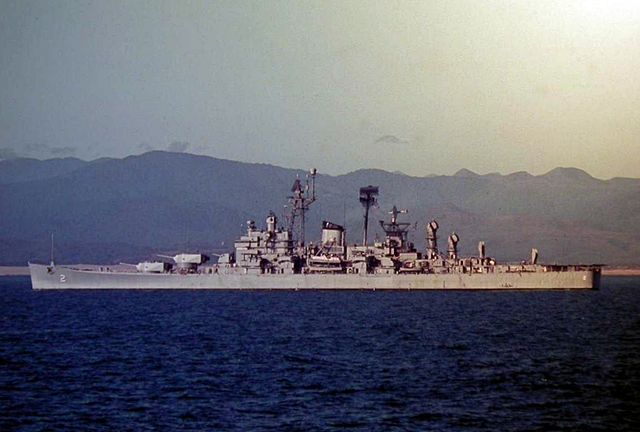
Canberra of South Vietnam in 1966
On 6 April 1967, seaman Doug Hegdahl was blown overboard by a 5-inch gun firing, was not picked up and later captured by a North Vietnamese gunboat, ending as POW for many years in “Hanoi Hilton”. His postwar recollection were used as alleged proof of torture in POW camps. By April 1967 Canberra visited Melbourne and in May took part in the Battle of the Coral Sea rememberance ceremonies.
The 1968 Tet Offensive scrambing south to support troops during the Battle of Hue. She fired an amazing 35,000 rounds in 31 days, emptying her storage. On 1 May 1968 while back home she was redeignated CA-70, but made a last deployment until early January 1969.
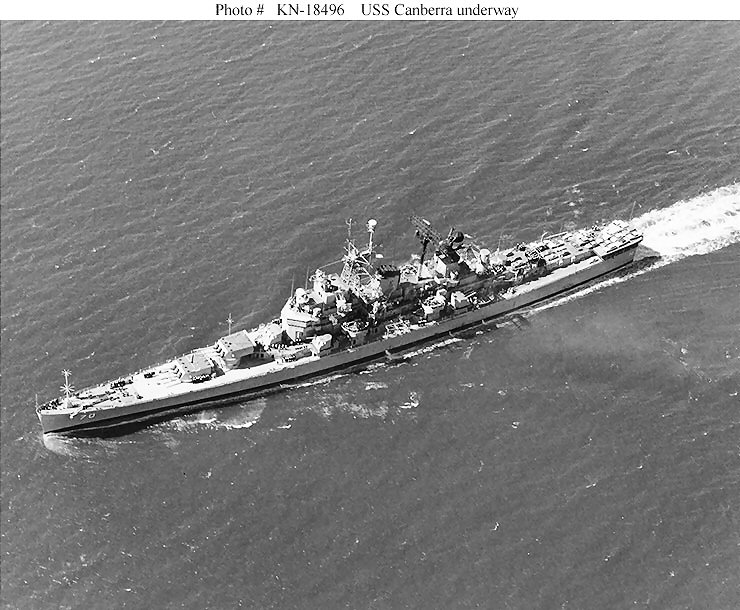
Underway for decommission in 1969, not it seems she lacked her aft FCS radars and Terrier launchers.
Back home she was decommissioned on 2 February 1970, but kept for long in mothball, then stricken on 31 July 1978, sold for scrap on 15 July 1980, sent to Suisun Bay Inactive Ship Maintenance Facility in August and BU.
One propeller is now on display at the Los Angeles Maritime Museum, her bell being later presented to Australian PM John Howard by George W. Bush on 10 September 2001 to commemorate the ANZUS treaty and is in the Australian National Maritime Museum today. She was not the last USS Canberra as the name was passed on recently to LCS-30.
In addition to her 7 WW2 battle stars she earned the Vietnam Service Medal with 4 campaign stars, and Republic of Vietnam Campaign Medal.
Read More
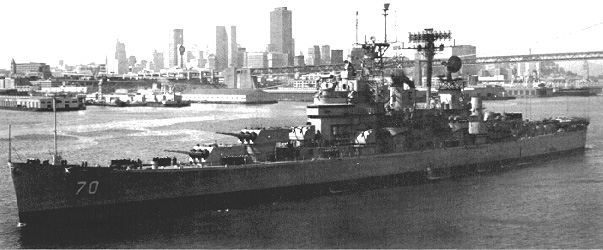
USS Canberra in 1971, en route for the scrapyard.
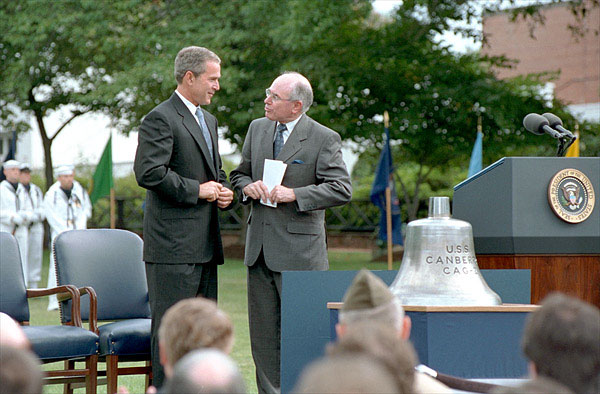
George W. Bush and John Howard during the presentation of Canberra’s bell to the Australian government at the occasion of the ANZUS treaty 50th anniversary
Books
Conway’s all the world’s fighting ships 1947-1995
Friedman, Norman (1984). U.S. Cruisers: An Illustrated Design History.
Bartholomew, Charles A., Captain USN; Milwee, William I., Jr., Commander USN (Ret) (2009). Mud, Muscle, And Miracles—Marine Salvage in the United States Navy. Washington, D.C.: Naval History & Heritage Command/Naval Sea Systems Command.
Cassells, Vic (2000). The Destroyers: Their Battles and Their Badges. East Roseville, NSW: Simon & Schuster.
Clark, Robin (March 2001). “The Fighting Canberras”. Canberra Historical Journal (47): 9–16.
Mellefont, Jeffrey (June 2008). “Two ships called Canberra”. Signals. Australian National Maritime Museum (83)
Links
cold-war us missile-cruisers
navypedia.org/
“Canberra”. Dictionary of American Naval Fighting Ships. Navy Department, Naval History & Heritage Command.
The fighting Canberras
on history.navy.mil
navsource.org canberra
navsource.org boston
en.wikipedia.org/ Boston-class
defensemedianetwork.com US transition to missiles
Model Kits

For one, there is the very old Revell kit to the unusual 1:480 scale.
There is also the Orange Hobby 1:350 and 1:700, USS Canberra CAG-2 by Iron Shipwrights 1:350 and one of Niko Models to 1:700, then the usual Fiberglass hull for USS Boston CAG-1
by The Scale Shipyard 1:96. For RC scratchbuilders. Full query on scalemates
See also the rendition of a 1:700 Niko model by Jörg Kuhnert

 Latest Facebook Entry -
Latest Facebook Entry -  X(Tweeter) Naval Encyclopedia's deck archive
X(Tweeter) Naval Encyclopedia's deck archive Instagram (@navalencyc)
Instagram (@navalencyc)





 French Navy
French Navy Royal Navy
Royal Navy Russian Navy
Russian Navy Armada Espanola
Armada Espanola Austrian Navy
Austrian Navy K.u.K. Kriegsmarine
K.u.K. Kriegsmarine Dansk Marine
Dansk Marine Nautiko Hellenon
Nautiko Hellenon Koninklije Marine 1870
Koninklije Marine 1870 Marinha do Brasil
Marinha do Brasil Osmanlı Donanması
Osmanlı Donanması Marina Do Peru
Marina Do Peru Marinha do Portugal
Marinha do Portugal Regia Marina 1870
Regia Marina 1870 Nihhon Kaigun 1870
Nihhon Kaigun 1870 Preußische Marine 1870
Preußische Marine 1870 Russkiy Flot 1870
Russkiy Flot 1870 Svenska marinen
Svenska marinen Søværnet
Søværnet Union Navy
Union Navy Confederate Navy
Confederate Navy Armada de Argentina
Armada de Argentina Imperial Chinese Navy
Imperial Chinese Navy Marinha do Portugal
Marinha do Portugal Mexico
Mexico Kaiserliche Marine
Kaiserliche Marine 1898 US Navy
1898 US Navy Sovietskiy Flot
Sovietskiy Flot Royal Canadian Navy
Royal Canadian Navy Royal Australian Navy
Royal Australian Navy RNZN Fleet
RNZN Fleet Chinese Navy 1937
Chinese Navy 1937 Kriegsmarine
Kriegsmarine Chilean Navy
Chilean Navy Danish Navy
Danish Navy Finnish Navy
Finnish Navy Hellenic Navy
Hellenic Navy Polish Navy
Polish Navy Romanian Navy
Romanian Navy Turkish Navy
Turkish Navy Royal Yugoslav Navy
Royal Yugoslav Navy Royal Thai Navy
Royal Thai Navy Minor Navies
Minor Navies Albania
Albania Austria
Austria Belgium
Belgium Columbia
Columbia Costa Rica
Costa Rica Cuba
Cuba Czechoslovakia
Czechoslovakia Dominican Republic
Dominican Republic Haiti
Haiti Hungary
Hungary Honduras
Honduras Estonia
Estonia Iceland
Iceland Eire
Eire Equador
Equador Iran
Iran Iraq
Iraq Latvia
Latvia Liberia
Liberia Lithuania
Lithuania Mandchukuo
Mandchukuo Morocco
Morocco Nicaragua
Nicaragua Persia
Persia San Salvador
San Salvador Sarawak
Sarawak Uruguay
Uruguay Venezuela
Venezuela Zanzibar
Zanzibar Warsaw Pact Navies
Warsaw Pact Navies Bulgaria
Bulgaria Hungary
Hungary

 Bundesmarine
Bundesmarine Dutch Navy
Dutch Navy Hellenic Navy
Hellenic Navy Marina Militare
Marina Militare Yugoslav Navy
Yugoslav Navy Chinese Navy
Chinese Navy Indian Navy
Indian Navy Indonesian Navy
Indonesian Navy JMSDF
JMSDF North Korean Navy
North Korean Navy Pakistani Navy
Pakistani Navy Philippines Navy
Philippines Navy ROKN
ROKN Rep. of Singapore Navy
Rep. of Singapore Navy Taiwanese Navy
Taiwanese Navy IDF Navy
IDF Navy Saudi Navy
Saudi Navy Royal New Zealand Navy
Royal New Zealand Navy Egyptian Navy
Egyptian Navy South African Navy
South African Navy






























 Ukrainian Navy
Ukrainian Navy dbodesign
dbodesign